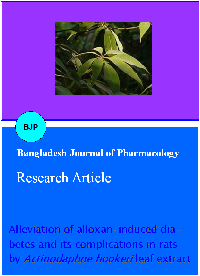Alleviation of alloxan-induced diabetes and its complications in rats by Actinodaphne hookeri leaf extract
DOI:
https://doi.org/10.3329/bjp.v3i2.946Keywords:
Actinodaphne hookeri, Alloxan, Antidiabetic, PhytomedicineAbstract
Leaves of Actinodaphne hookeri Meissn (Family Lauraceae; local name: Pisa) has been in use traditionally for the treatment of diabetes and disorders of the urinary tract which are more common in Chattisgarh and eastern part of India. In the present study, leaves of A. hookeri were subjected to phytochemical investigation and evaluated for anti-diabetic activity. The ethanol and the chloroform extract were found to have significant (p<0.01) blood glucose lowering effect. The extracts also significantly (p<0.01) lowered the increased serum cholesterol and low density lipoprotein levels. Preliminary phytochemical investigation revealed the presence of alkaloids, flavonoids, triterpenoids and glycosides as the major constituents in the ethanol extract. The chloroform extract also showed significant (p<0.01) antihyperglycemic activity and contained alkaloids and triterpenes. It is concluded that the antidiabetic activity of A. hookeri may be due to the presence of alkaloids and triterpenes, and might be promising for the development of phytomedicine for diabetes mellitus along with its associated complications.
Downloads
278
181 Read
36
References
Anonymous. The wealth of India: Raw material. In: Actinodaphne. New Delhi, Publication and Information Directorate CSIR, 2003, pp 70-71.
Atkinson MA, Maclaren NK. The pathogenesis of insulin dependent diabetes mellitus. New Engl J Med. 1994; 331: 142836.
Babu V, Gangadevi T, Subramanian A. Anti-hyperglycemic activity of cassia kleinii leaf extracts in glucose fed normal rats and alloxan-induced diabetic rats. Indian J Pharmacol. 2002; 34: 409-15.
Chopra RN, Nayar SL, Chopra IC. Glossary of Indian medicinal plants. In: Actinodaphne hookeri. New Delhi, Publication & Information Directorate CSIR Press, 1956, p 6.
Cromwell BT, Peach K, Tracey MV. Modern methods of plant analysis. In: Alkaloids. Vol. 3. 1st ed. Berlin, Springer Verlag, 1955, pp 373-74.
Finar IL. Organic chemistry stereochemistry and chemistry of natural products. Vol. 2. London, Longman Scientific and Technical Press, 1975, p 518.
Geinssman TA. Modern methods of plant analysis. In: Flavonoids. Vol. 3. Berlin, Springer Verlag, 1955, pp 467-74.
Hawks PB. Physiological chemistry. In: Carbohydrates. New Delhi, Tata McGraw Hill Publishing Company Ltd, 1971, p 373.
Kannur DM, Hukkeri VI, Akki KS. Anti-diabetic activity of Caesalpinia bonduucella seed extracts in rats. Fitoterapia 2006; 77: 546-49.
Kirtikar KR, Basu BD. Indian medicinal plants. In: Actinodaphne. Vol. 3. 2nd ed. Dehradun, India International Book Distributors, 1995, pp 2156-57.
Kokate CK, Purohit AP, Gokhale SB. Pharmacognosy. In: Alkaloid. 26th ed. Pune, Nirali Prakashan, 1996, p 447.
OECD. Organization for economic co-operation and development. In: Acute oral toxicity guidelines 420, Paris, 2001, pp 12-14.
Pillai M. Readers Digest. In: Could you be a diabetic. New Delhi, Living Media India Limited Press, 2006, p 138.
Rang HP, Dale MM, Ritter JM, Moore PK. Pharmacology. In: The endocrine pancreas and the control of blood glucose. London, Churchil Livingstone, 2001, pp 385-92.
Trease GE, Evans WC. Pharmacognosy. In: Phenols and phenolic glycosides. London, ELBS, 1989, pp 223-24, 246-49.
Vogel GH, Gang W. Drug discovery and evaluation pharmacological assay. In: Methods to induce experimental diabetes mellitus. Heidelberg, Springer Verlag, 2002, p 950.
Yoganarasimhan SN. Medicinal plants of India. In: Actinodaphne hookeri. Vol. 1. Bangalore, Interline Publishing Pvt. Ltd, 2000, p 13.

Additional Files
Published
How to Cite
Issue
Section
License
Authors who publish with this journal agree to the following terms:
- Authors retain copyright and grant the journal right of first publication with the work simultaneously licensed under a Creative Commons Attribution License that allows others to share the work with an acknowledgement of the work's authorship and initial publication in this journal.
- Authors are able to enter into separate, additional contractual arrangements for the non-exclusive distribution of the journal's published version of the work (e.g., post it to an institutional repository or publish it in a book), with an acknowledgement of its initial publication in this journal.
- Authors are permitted and encouraged to post their work online (e.g., in institutional repositories or on their website) prior to and during the submission process, as it can lead to productive exchanges, as well as earlier and greater citation of published work (See The Effect of Open Access).
